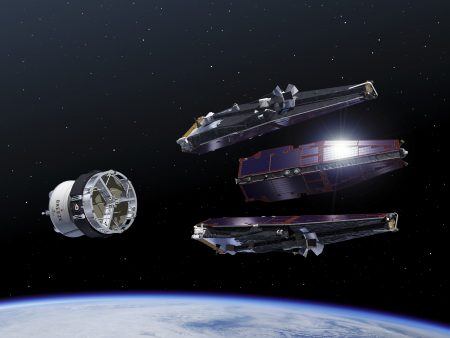April 12, 2018 – Who knew that Earth has two magnetic fields? No one until ESA, the European Space Agency’s Swarm Mission, a trio of small satellites, discovered the second one through four years of data gathering which produced details of a previously unknown field correlated to the movements of the ocean crust and the seawater lying above it.
The newly discovered field when measured by the Swarm satellites exerts an electric force of between 2 and 2.5 nano-Teslas. That compares to the major magnetic field at between 25 to 65 micro-Teslas. If you are not familiar with Tesla as a measure of electromagnetic force, one is equivalent to a force of 1 newton traveling through a uniform magnetic field at a speed of 1 meter per second. The nano-Tesla represents a force that is one billionth of a Tesla.
The new field is 20,000 times weaker than the global geomagnetic field that protects us from incoming solar and cosmic radiation. That field is generated by the Earth’s spinning molten iron core. This new field owes its existence to magnetic properties found in the lithosphere, the surface crust of the planet, as well as the magnetic properties inherent in seawater.
When Swarm was first launched in 2013, it was designed to measure how the geomagnetic field is generated, how it behaves, and how and if it is changing. But the satellites soon detected a secondary magnetic field coming from the ocean itself and the seabed floor. States Erwan Thebault, from the University of Nantes, in France, the data from Swarm has given us the ability to “see structures in the crust like never before” including this newly discovered weak magnetic field undetectable until now because the stronger global magnetic field hides it.
What Swarm discovered is a characteristic of saltwater in the ocean to generate an electric current as it passes through the geomagnetic field. This is a field that is extremely difficult to measure but Swarm has done it by studying ocean tides. This tidal magnetic field changes over a 24-hour period.
And as ocean plates get moved along by the mantle conveyor belt and new iron-rich mineral well up to the surface of the seabed, they capture Earth’s magnetic perturbations including the periodic flipping of the geomagnetic field.
The new discovery adds to previously discovered strips of ocean crust that show periodic magnetic reversals providing a snapshot of Earth’s tectonic and geological history over hundreds of millions of years.









